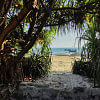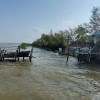Unesco team visits Sundarbans to assess power plant impact

A high-profile Unesco delegation today visited the Sundarbans to assess the possible impacts of the proposed coal-based Rampal power plant and vessel plying through the mangrove forest.
The Unesco team visited the site of coal-based Rampal power plant project earlier on Wednesday, while the Shela River on Thursday where a tanker carrying about 350,000 litres of furnace oil crashed on
December 9, 2014 and a cargo sank on March 19.
The delegation members will meet senior officials of Mongla Port Authority on Friday. Later, they will meet officials of relevant ministries and departments on March 28 next.
The members of ‘Unesco Reactive Monitoring Team’ are Fanny Adolphinem Douver, Naomi Clare Doak and Mizuki Murai.
Forest officials, including deputy secretary Dr M Mohiuiddin, and researchers and teachers of Khulna University accompanied the Unesco team during its visit to the Sundarbans.
Unesco team coordinator and senior assistant secretary Sheikh M Towhidul Islam told UNB that the team has already visited different points of the Sundarbans, including the Shila River where there had been oil spill.
The Sundarbans is situated about 14 kilometres away from the proposed 1,320-megawatt coal-based power plant site, which is a joint venture of Bangladesh Power Development Board and the National Thermal Power Corporation Limited of India under the name of Bangladesh-India Friendship Power Company.
Environment experts warn that the Rampal Power Plant project will bring more harm to the country than good, destroying the Unesco World Heritage site, since the climate, topography, land use pattern, wetlands, floral and faunal diversity and quality of air and water in the Sundarbans will be affected due to the power plant.
According to the Environment Impact Assessment of the project, the Rampal Power Plant will produce 7.5 lakh tonnes of fly ash and 2 lakh tonnes of bottom ash per year. About 15 percent of the ash will be generated as a result of burning coal.
The Rampal Power plant site is located about 14 kilometres away from the Sundarbans, a habitat to the Bengal tigers and endangered Irrawaddy dolphin. But the peripheral area of the forest begins within four kilometres from the power plant.

 For all latest news, follow The Daily Star's Google News channel.
For all latest news, follow The Daily Star's Google News channel. 








Comments